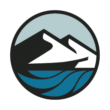National Heritage Areas are based on partnerships: bringing together a range of Tribes, organizations, businesses, and governments around heritage resources and stories. One of our partners is the Port Townsend Foundry. If you are interested in becoming a partner, learn more on our become a partner page.
Many museums and educational institutions have front-desk staff, but few are as dedicated to their role as Sally the Sea Otter. Peeking out from her home in a diorama of Ruby Beach, Sally sits near the door of Ocean Shores’ Coastal Interpretive Center and greets visitors as they come to learn about Washington’s coastline.
Sally is a large taxidermy sea otter and is the first exhibit people notice walking into the Center. She chaperones the entrance, teaching visitors about the localized extinction of sea otters in the early 1900s, and the recent resurgence of their population thanks to the efforts of scientists and researchers. With a kelp garden hanging from the ceiling nearby, she also stands as a model for what people will experience walking through the Center: user-friendly, hands-on experiences and high-quality educational exhibits about Washington’s Pacific coastline.
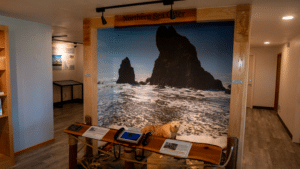
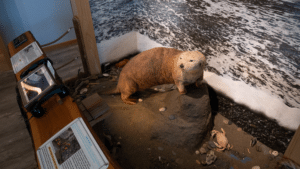
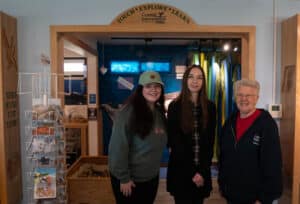
With a range of focus stretching from the Columbia River on Washington State’s southern border to Cape Flattery at the north, the Center shares knowledge about the wildlife, ecology, geology, history, industry, and people that all exist along this expansive and important landscape.
The Center has worked since 1977 to educate residents and visitors alike about coastal wildlife and features. Over the decades, it has changed names and ownership, but it has been managed since 2012 by the nonprofit Friends of Ocean Shores Coastal Interpretive Center. Recently, the Center used its closure due to COVID-19 as an opportunity to extensively remodel. With 8000+ hours of volunteer time and nearly 300 members, the Center is a true community project, powered by volunteers with a passion for the wonders of the coast.
Engagement and Fun
“I think my favorite part is getting to see everything through the kids’ eyes when we do education programs,” said Education Coordinator Rachel Davey. “[I] really see…the actual mission happening where you’re inspiring this wonder and joy of nature.”
Among the highest goals of the Center is to educate the public about Washington’s coastline and its host city, Ocean Shores. With five permanent galleries and many more outdoor exhibits and trails, the Center displays the natural and cultural history of the region through many different types of media. Both hands-on and readable interpretive displays help the Center to share a diverse range of stories about the coast, both today and throughout history. The opportunities to touch and experience maritime history are plentiful. Kids can participate in scientific investigations, measure themselves against a moose shadow, pilot a container ship through a storm, and feel whale bones and baleen.
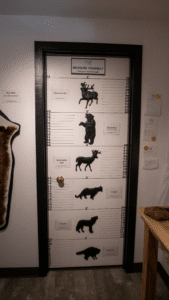
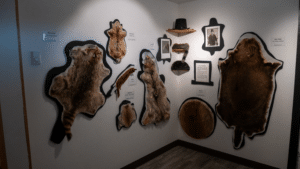
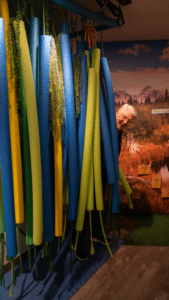
The collections at the Center are managed by Laura Caldwell, Collections Manager and Center Administrator. She says her favorite part of her job is getting the opportunity to research and learn about the region’s culture and history.
Exhibits and Opportunities
Just past Sally the Sea Otter, a looping video plays information about spawning Coho Salmon. The geology displays in the next room glitter with unique minerals like “fulgurite,” made from the lightning strike-like explosion of a transformer in sand. Interpretive displays and artistic renderings of the geological record tell stories about Washington’s ancient past, and local artists attempt to capture “King Tides and Winter Storms” in art displayed on the wall. Walking deeper into the Center, the walls are decorated with remnants of shore debris.
Laura’s passion for the region is evident from the care taken with each diorama and display. The collection of taxidermy animals, each carefully numbered for easy reference, echoes a magical scene from a fairy tale, where mountain goats, raccoons hiding in logs, hawks, owls, geese, ducks, and deer all share in one space.
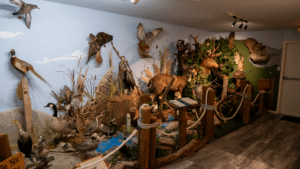
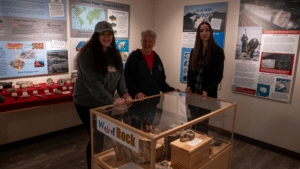
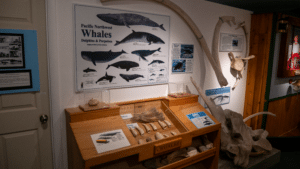
Continuing past the forest of taxidermy creatures, dioramas tell stories about Quinault Tribal fishing villages. Around the corner from the woven baskets are artifacts from ships wrecked on nearby beaches. The Center’s exhibits encourage guests to feel wonder for their community with interactive games like a bird identification quiz.
Despite the already expansive collection already on display, they have “so many things that we can be showing in exhibits…[but] we have no more space,” said Board President Jean Stevens. In a back room, a porpoise skeleton waits in cardboard boxes to be articulated and displayed. There is an antique sweater from a local celebrity awaiting display in a flat storage cabinet, and two other rooms full of potential exhibits.
Tourism and Winter Programming
Ocean Shores is a beachfront town supported by summer tourism, so the winter season tends to have more downtime for the Center’s team. Filling the calmer winter months with regular “Drink & Draw” events, guided tours through the center, planning, and lecture sessions, the team keeps themselves busy year-round.
Rachel and Laura, the Center’s two full-time staff members, also host school field trips. They utilize their extensive collection and diverse exhibits to meet students where they are in school, with programs for all grade levels. Some local students are even invited to create submersibles used to monitor a local waterway year-round.
Once summer rolls around, things kick into high gear for the team. Tourists visit regularly, and the Center relies on a team of docent volunteers to help manage admission, inform about exhibits, and sell educational materials from their bookstore.

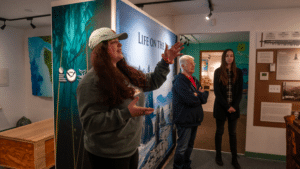
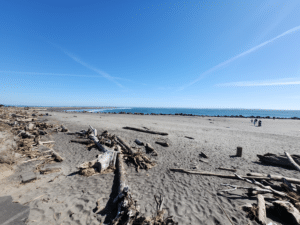
“Bring[ing] these stories to people, it’s so important to us and such an integral part of what we do here,” said Rachel. “That magic—its foundation is maritime heritage and natural history.”
That sense of magic is palpable at the Coastal Interpretive Center during the springtime. Wildlife abounds, from the northern red-legged frog sitting on a rock in the pond to the river otters running across the road near Ocean Shores’ southernmost jetty. Waves crash on the beach just yards away, barely obscured by the tall beach grass. When summer comes, the Center will be bustling with interest and education, and their team will be ready to share in the joy and wonder of nature.

